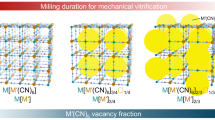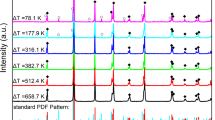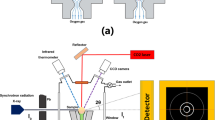Abstract
Understanding the conditions that favour crystallization or vitrification of liquids has been a long-standing scientific problem1,2,3. Another connected, and not yet well understood question is the relationship between the glassy and the various possible crystalline forms a system may adopt4,5. In this context, B2O3 represents a puzzling case. It is one of the best glass-forming systems despite an apparent lack of low-pressure polymorphism. Furthermore, the system vitrifies in a glassy form abnormally different from the only known crystalline phase at ambient pressure6. Last but not least, it never crystallizes from the melt unless pressure is applied, an intriguing behaviour known as the crystallization anomaly7,8,9. Here, by means of ab initio calculations, we discover the existence of previously unknown B2O3 crystalline polymorphs with structural properties similar to the glass and formation energies comparable to the known ambient crystal. The energy degeneracy of the crystals, which is high at ambient pressure and suppressed under pressure, provides a framework to understand the system’s ability to vitrify and the origin of the crystallization anomaly. This work reconciles the behaviour of B2O3 with that from other glassy systems and reaffirms the role played by polymorphism in a system’s ability to vitrify10,11. Some of the predicted crystals are cage-like materials entirely made of three-fold rings, opening new perspectives for the synthesis of boron-based nanoporous materials.
This is a preview of subscription content, access via your institution
Access options
Subscribe to this journal
Receive 12 print issues and online access
$259.00 per year
only $21.58 per issue
Buy this article
- Purchase on Springer Link
- Instant access to full article PDF
Prices may be subject to local taxes which are calculated during checkout




Similar content being viewed by others
References
Cohen, M. H. & Turnbull, D. Composition requirements for glass formation in metallic and ionic systems. Nature 189, 131–132 (1961).
Bhat, M. H. et al. Vitrification of a monoatomic metallic liquid. Nature 448, 787–790 (2007).
Shintani, H. & Tanaka, H. Frustration on the way to crystallization in glass. Nature Phys. 2, 200–206 (2006).
Sheng, H. W., Luo, W. K., Alamgir, F. M., Bai, J. M. & Ma, E. Atomic packing and short-to-medium-range order in metallic glasses. Nature 439, 419–425 (2006).
Martin, J. D., Goettler, S. J., Fossé, N. & Iton, L. Designing intermediate-range order in amorphous materials. Nature 419, 381–384 (2002).
Youngman, R. E., Haubrich, S. T., Zwanziger, J. W., Janicke, M. T. & Chmelka, B. F. Short- and intermediate-range structural ordering in glassy boron oxide. Science 269, 1416–1420 (1995).
Kracek, F. C., Morey, G. W. & Merwin, H. E. The system water–boron oxide. Am. J. Sci. 35A, 143–171 (1938).
Ulhmann, D. R., Hays, J. F. & Turnbull, D. The effect of high pressure on B2O3: Crystallisation, densification, and the crystallisation anomaly. Phys. Chem. Glasses 8, 1–10 (1967).
Aziz, M. J., Nygren, E., Hays, J. F. & Turnbull, D. Crystal growth kinetics of boron oxide under pressure. J. Appl. Phys. 57, 2233–2242 (1985).
Wang, R. & Merz, M. D. Non-crystallinity and polymorphism in elemental solids. Nature 260, 35–36 (1976).
Goodman, C. H. L. Strained mixed-cluster model for glass structure. Nature 257, 370–372 (1975).
Desiraju, G. R. Crystal gazing: Structure prediction and polymorphism. Science 278, 404–405 (1997).
Llinàs, A. & Goodman, J. M. Polymorph control: Past, present and future. Drug Discov. Today 13, 198–210 (2008).
Elliot, S. R. Physics of Amorphous Materials (Longman, 1990).
Piccione, P. M. et al. Thermochemistry of pure-silica zeolites. J. Phys. Chem. B 104, 10001–10011 (2000).
Price, S. L. Computed crystal energy landscapes for understanding and predicting organic crystal structures and polymorphism. Acc. Chem. Res. 42, 117–126 (2009).
Sali, A., Shakhnovich, E. & Karplus, M. How does a protein fold? Nature 369, 248–251 (1994).
Lee, S. K. et al. Probing of bonding changes in B2O3 glasses at high pressure with inelastic X-ray scattering. Nature Mater. 4, 851–854 (2005).
Umari, P. & Pasquarello, A. Fraction of boroxol rings in vitreous boron oxide from a first-principles analysis of Raman and NMR spectra. Phys. Rev. Lett. 95, 137401 (2005).
Ferlat, G. et al. Boroxol rings in liquid and vitreous B2O3 from first-principles. Phys. Rev. Lett. 101, 065504 (2008).
Huang, L. & Kieffer, J. Thermomechanical anomalies and polyamorphism in B2O3 glass: A molecular dynamics study. Phys. Rev. B 74, 224107 (2006).
Wright, A. C. Borate structures: Crystalline and vitreous. Phys. Chem. Glasses: Eur. J. Glass Sci. Technol. B 51, 1–39 (2010).
McCulloch, L. A crystalline boric oxide. J. Am. Chem. Soc. 59, 2650–2652 (1937).
Kline, D., Bray, P. J. & Kriz, H. M. Structure of crystalline boron oxide. J. Chem. Phys. 48, 5277–5278 (1968).
Takada, A., Catlow, C. R. A. & Price, G. D. Computer modelling of B2O3: I. New interatomic potentials, crystalline phases and predicted polymorphs. J. Phys. Condens. Matter 7, 8659–8692 (1995).
Takada, A., Catlow, C. R. A. & Price, G. D. Computer synthesis of B2O3 polymorphs. Phys. Chem. Glasses 44, 147–149 (2003).
Huang, L., Durandurdu, M. & Kieffer, J. New B2O3 crystals predicted from concurrent molecular dynamics simulations and first-principles calculations. J. Phys. Chem. C 111, 13712–13720 (2007).
Winkler, B., Pickard, C. J., Milman, V. & Thimm, G. Systematic prediction of crystal structures. Chem. Phys. Lett. 337, 36–42 (2001).
Joo, C., Werner-Zwanziger, U. & Zwanziger, J. W. The ring structure of boron trioxide glass. J. Non-Cryst. Solids 261, 282–286 (2000).
Shmidt, N. E. Heat capacity and heat of fusion of crystalline boron oxide. Russ. J. Inorg. Chem. 11, 241–247 (1966).
Cole, S. S. & Taylor, N. W. The system Na2O–B2O3 I preparation of crystalline and some of its physical properties. J. Am. Ceram. Soc. 18, 55–58 (1935).
Kocakusak, S. et al. Production of anhydrous, crystalline boron oxide in fluidized bed reactor. Chem. Eng. Proc. 35, 311–317 (1996).
Lange, F. F. Chemical solutions routes to single-crystal thin films. Science 273, 903–909 (1996).
Brunner, G. O. & Meier, W. M. Framework density distribution of zeolite-type tetrahedral nets. Nature 337, 146–147 (1989).
Côté, A. P. et al. Porous, crystalline, covalent organic frameworks. Science 310, 1166–1170 (2005).
Soler, J. M. et al. The Siesta method for ab initio order- N materials systems. J. Phys. Condens. Matter 14, 2745–2779 (2002).
Ferlat, G. et al. Ab initio calculations on borate systems. Eur. J. Glass Sci. Technol. B 47, 441–444 (2006).
Clark, S. J. et al. First-principles methods using Castep. Z. Kristallogr. 220, 567–570 (2005).
Vanderbilt, D. Soft self-consistent pseudopotentials in a generalized eigenvalue formalism. Phys. Rev. B 41, 7892–7895 (1990).
Perdew, J. P., Burke, K. & Ernzerhof, M. Generalized gradient approximation made simple. Phys. Rev. Lett. 77, 3865–3868 (1996).
Acknowledgements
This work was performed using HPC resources from GENCI-CINES/IDRIS (Grant x2010081875). We thank Ph. Depondt and E. Lacarce for critical reading of the manuscript.
Author information
Authors and Affiliations
Contributions
G.F. and F.M. conceived the study and with M.L. designed the simulations. G.F. implemented the simulations with help from A.P.S., ran the simulation and wrote the manuscript. All authors contributed to the discussion and interpretation of the results.
Corresponding authors
Ethics declarations
Competing interests
The authors declare no competing financial interests.
Supplementary information
Supplementary Information
Supplementary Information (PDF 890 kb)
Rights and permissions
About this article
Cite this article
Ferlat, G., Seitsonen, A., Lazzeri, M. et al. Hidden polymorphs drive vitrification in B2O3. Nature Mater 11, 925–929 (2012). https://doi.org/10.1038/nmat3416
Received:
Accepted:
Published:
Issue Date:
DOI: https://doi.org/10.1038/nmat3416
This article is cited by
-
Energy landscapes of perfect and defective solids: from structure prediction to ion conduction
Theoretical Chemistry Accounts (2021)
-
The microscopic origin of the extreme glass-forming ability of Albite and B2O3
Scientific Reports (2017)
-
The Perfect Glass Paradigm: Disordered Hyperuniform Glasses Down to Absolute Zero
Scientific Reports (2016)



